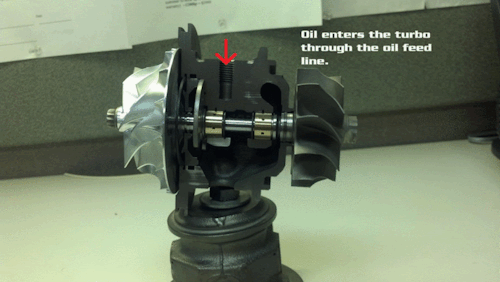Troubleshooting
Turbo is Smoking
The first thing to consider is that your turbo does not have "seals" that are prone to "blowing". What people refer to as “seals” are actually gas control rings (see the GIF posted below for a visual) which sit in grooves on the turbine shaft and the compressor side seal plate. These act much like piston rings, in that their main function is not to keep oil in, but rather they are in place to keep pressure from the turbine and compressor housings out of the center cartridge of the turbo. Since these rings ride in metal grooves, there is no way for them to become damaged without the turbo showing a significant amount of shaft play. The rule of thumb here is this: if your turbo doesn’t have excessive shaft play, your “seals” are fine.
There are, however, a few ways for oil to be forced through these gaps into the housings. We’ll cover them from simplest to the most complicated, in that order. To give a visual reference, here is a GIF showing a cutaway of a bearing housing.

Your drain tube is not up to par
Most turbochargers we sell have about a half inch orifice to allow oil to drain out of the bearing housing. This is 100% gravity fed and has no pressure to push it through. Any sort of obstruction can throw the balance off and allow oil to back up inside the bearing housing and seep through the gas control rings. It could be something as simple as a kink, too much RTV, or just inferior tubing that is starting to collapse internally. A less common cause, and something that is usually a problem on cars that weren’t originally turbocharged, is that the drain flange on the oil pan is below the fill level.
You’re feeding the turbo too much oil
Most of the turbos operate under the assumption that they will see a max oil pressure of 70-80psi. If the car is supplying more than that, there is a chance you can overcome the turbo's drain ability and it will cause the bearing housing to back up and seep oil out of the gas control rings. This particular issue can be a little harder to diagnose as it usually requires a oil pressure gauge metering from the same place the turbo is feeding from.
Your PCV system is not functioning correctly
Your stock system is typically a two vacuum system. One vacuum is pulled from the valve cover, through the PCV valve, and ending at the intake manifold. Another pulls from the valve cover and goes to the intake of the turbocharger. The valve cover to intake manifold line is used to control PCV during idle and cruising and the other is used under boost. A lot of people making higher than factory numbers ignore their crankcase or make it worse by removing these vacuum sources and this can lead to smoking and oil deposits in your intake or intercooler pipe.
If the stock setup is no longer working for you, the proper way to run this setup is to enlarge the diameter of the hoses connecting to your system. A functional, if slightly overkill, setup, is to run two -10 lines, via fittings welded to the valve cover, to a catch can then another -10 line from the catch can to the intake. This allows for greater volume through the lines and still pulls a vacuum to ensure that all crankcase pressure is being alleviated.
We also have people convince themselves that the turbo is the issue because they swap from one turbo that does not smoke to one that does. Unless it’s the same exact model of turbocharger, this is not a valid test. Each turbo has a different bearing housing design. Some have giant valleys for the oil return like the Journal Bearing Red/Green/Black because they require a lot of oil to be properly lubricated. Their ball bearing counter parts have much smaller cavities because they require much less oil to operate.
If your turbo is smoking and the wheels aren’t clanking off the housings, it’s safe to assume that your issue lies elsewhere.
Turbo Does Not Make Boost
If your turbocharger appears to be in normal functioning order, but does not build positive pressure, the first thing you'll want to do is a boost leak test. There are numerous articles and videos explaining how to accomplish this, so it won't be rehashed here. Suffice it to say, if there is any significant leak in your intercooler and intake system, you will see massive inefficiencies and you can possibly hurt the turbo by overspinning it.
If a boost leak test does not show any issue, but you still are not generating positive pressure, you may have a leak between the cylinder head and the turbo. This should be apparent with the increased exhaust noise and air escaping from somewhere, likely at a flange or coupling.
Turbo Makes Scary Noises
If you can hear anything besides normal turbo noises, either you've got an exhaust leak, or more importantly, you've got internal components in the turbo touching during rotation. The most typical would be compressor wheel touching the compressor cover. If you hear any noise like this, you likely have a critical failure and should shut the car down immediately and inspect and/or remove to send in to us for repair.
